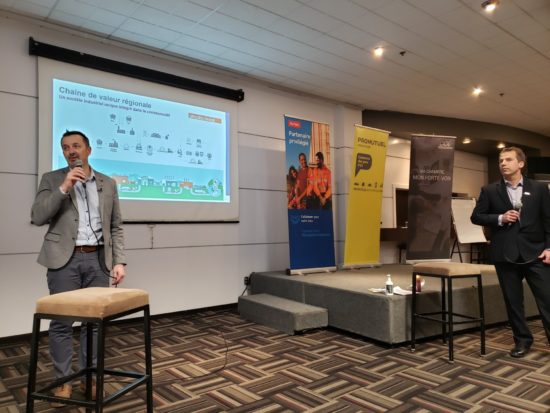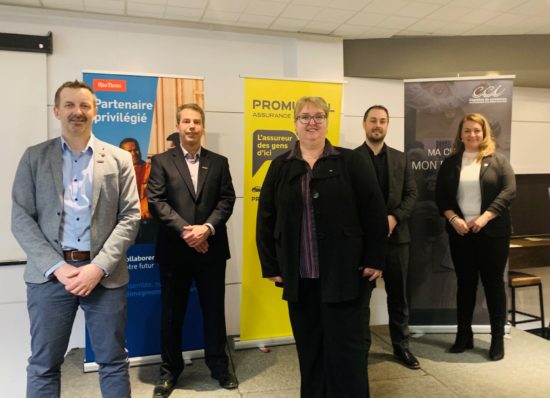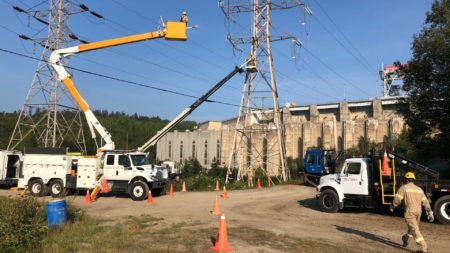Together, Toward a Sustainable, Inspiring and Promising Future | Conference

A scene from the conference luncheon held by the Chambre de commerce et d’industrie Lac-Saint-Jean-Est on 23 March, attended by about 70 industry representatives and Rio Tinto employees.
On 23 March, Patrice Bergeron and Stéphane Larouche, Operations Directors at Alma Works and Power Operations, respectively, were speakers at the conference luncheon of the Chambre de commerce et d’industrie Lac-Saint-Jean-Est, taking place for the first time since the beginning of the pandemic. Rio Tinto, which has reached the milestone of 95 years of hydropower and aluminium production in the region in 2021, is focused on working with communities to create a sustainable, inspiring and promising future.
Addressing nearly 70 industry representatives and employees, Bergeron and Larouche spoke enthusiastically and optimistically about the current state of the aluminium market, the progress being made on major projects and their vision for responsible aluminum, the key to a strong future.

{%CAPTION%}
Aluminium Market: Sustainable Goods Impact Demand
Rio Tinto’s operations in Saguenay–Lac-Saint-Jean produce aluminium using renewable energy and are thus very well positioned in a world moving toward decarbonisation. “This is a new era for the aluminium market,” Bergeron explained. “It’s no longer just a question of production volume. We need to produce aluminium responsibly. We have five aluminium smelters in the region that, all together, produce 1.2 million tonnes of aluminium. In China, there are about 170 aluminium smelters, and one alone can produce 3 million tonnes per year. Rio Tinto’s vision for the future involves decarbonising the entire value chain and producing even more responsible aluminium.” This means using renewable energy and having a positive impact on the local economy and society, not to mention product traceability, recycling and the circular economy, which includes reclaiming by-products.
Sustainable goods, such as electric vehicles, cans and power cables for renewable energy applications, influence the demand for aluminium. “Our aluminium plays a key role in building a more responsible world,” Larouche added. “Thanks to our use of hydropower, Quebec’s aluminium is already among the cleanest and most responsible in the world, generating seven to eight times less CO2 emissions than aluminium produced in other parts of the world. Our teams are focused on improving continuously and reaching extremely ambitious targets, namely a 50% reduction in GHG emissions by 2030 and net zero by 2050.”
Investments Consistent with a Zero Carbon Target
It is much to the benefit of Rio Tinto that aluminium prices have risen nearly 50% over one year, especially after several years of difficult conditions. While it is a good period for the aluminium industry, nothing can be taken for granted, and decisions are being made for the long term and not on the basis of short-term fluctuations. “Our objective remains the same,” said Bergeron. “We need to ensure that our operations stay globally competitive and in line with our decarbonisation goals.”
In 2021 alone, more than C$500 million has been invested in Saguenay–Lac-Saint-Jean facilities. Bergeron explained, “At Alma, our efforts are currently focused on the construction of commercial-sized ELYSIS pots, which are scheduled to be commissioned in 2023. In Canada alone, the ELYSIS technology has the capacity to reduce GHG emissions by seven million tonnes, which is the equivalent of taking 1.8 million cars off the road.”
In addition, the refurbishment of the anode baking furnaces at Alma Works, a $135-million project launched in 2020, will increase amperage from 400 kA to 420 kA, thereby increasing production by 25,000 tonnes per year.
Let’s shift our attention to Power Operations, the Isle-Maligne Power Station in Alma. The facility, which will be 100 years old in 2026, holds a strategic position for the future of low-carbon aluminium production in the region. “Since 2020, more than $250 million has been allocated to the Isle-Maligne Power Station,” said Larouche. “This represents about $190 million flowing into the Quebec economy. With current and future investments, we are protecting our assets for the long term to ensure that our operations remain strong. The modernisation of the Isle-Maligne Power Station is a comprehensive programme that includes several projects. Some of these projects have already begun, such as the major rehabilitation of 20 butterfly valves and turbine-generator unit 7 and equipment replacement for turbine-generator unit 2. Other projects are being reviewed or to be determined.
Recent investments in the Saguenay area include 16 new pots at Complexe Jonquière to increase production capacity, the modernisation of wharves at Rio Tinto port facilities, the modernisation of Vaudreuil Works and the new remelt furnace at Laterrière Works.
Our vision is clear: Rio Tinto aluminium with the lowest carbon footprint is the way of the future. “For nearly a century, we have been building a relationship of trust with the community,” said Larouche. “And we will continue to cultivate this relationship as we shift to a more environmentally responsible future. We will meet our challenges through hard work, targeted investments, the expertise of our teams, new technologies and collaboration with regional stakeholders and businesses.”

Pictured: Stéphane Larouche, Operations Director, Power Operations; Patrice Bergeron, Operations Director, Alma Works; Esther Brassard, Promutuel du Lac au Fleuve; Maxime Néron, President, Chambre de commerce et d’industrie Lac-Saint-Jean-Est (CCI LSJE); and Kathleen Voyer, Director General, CCI LSJE.


